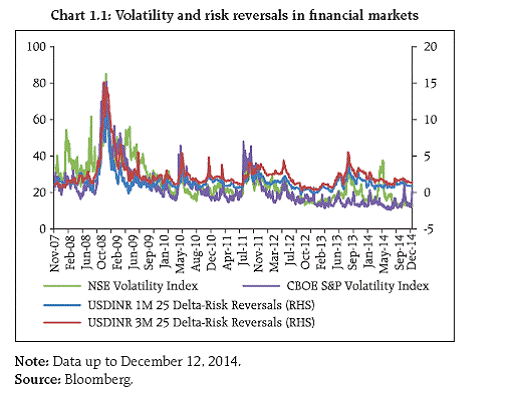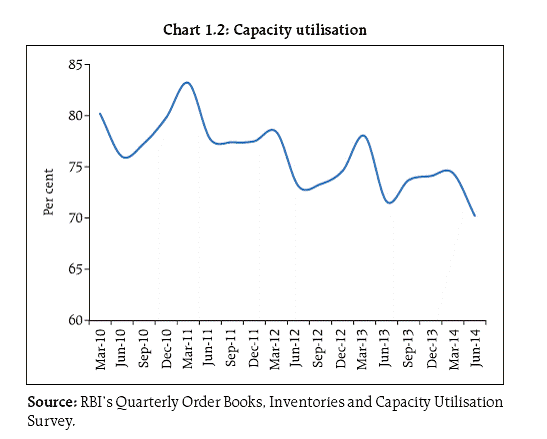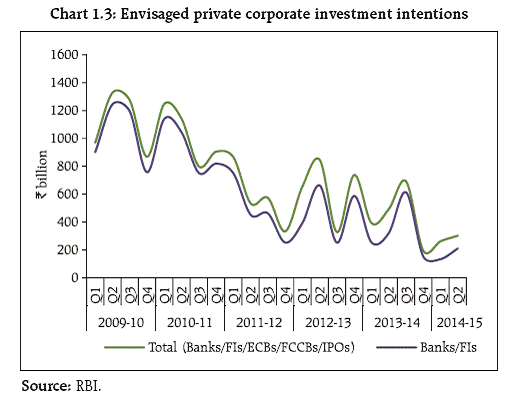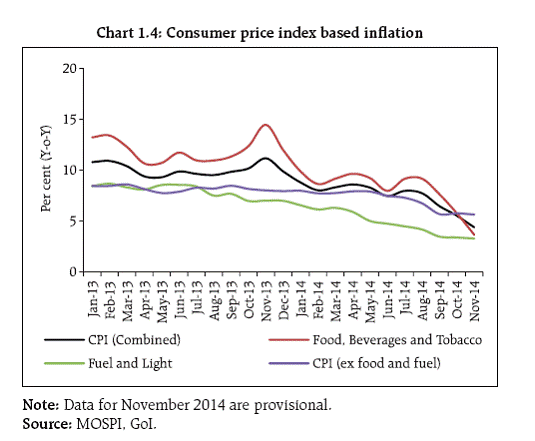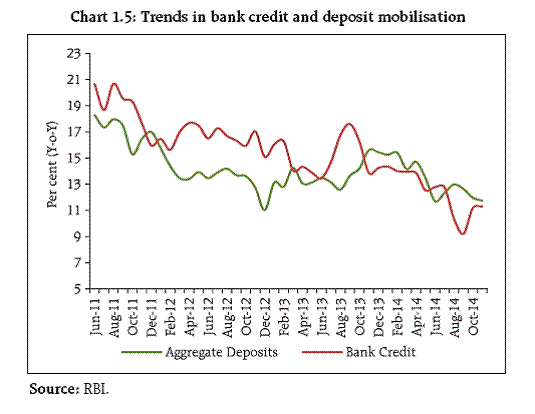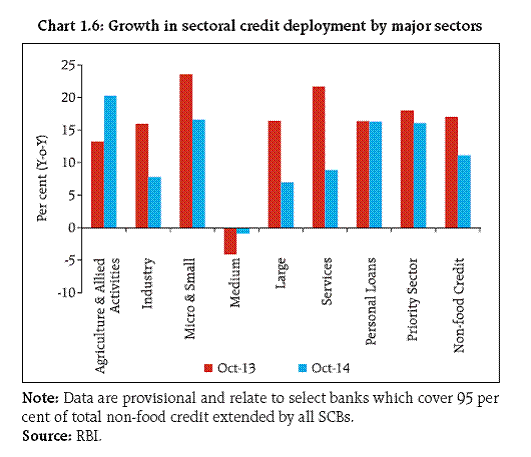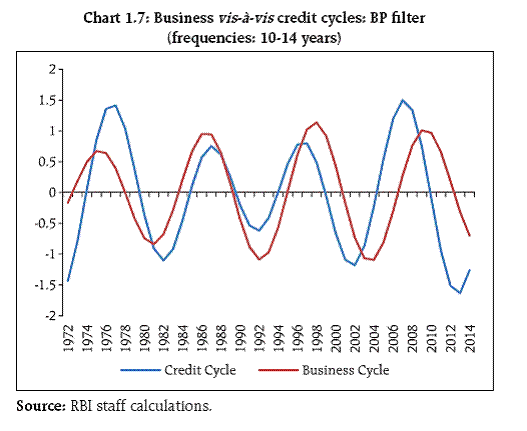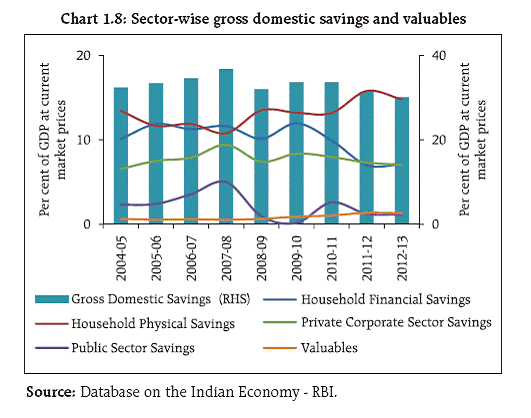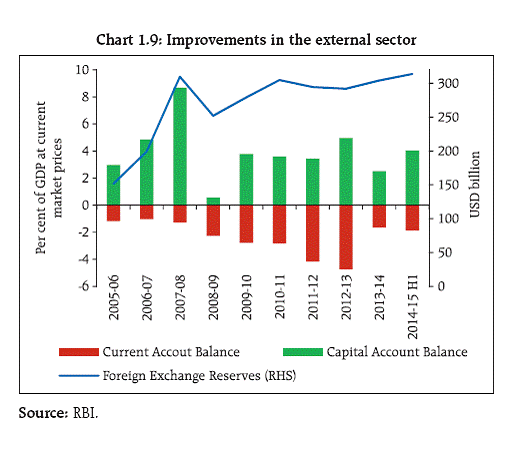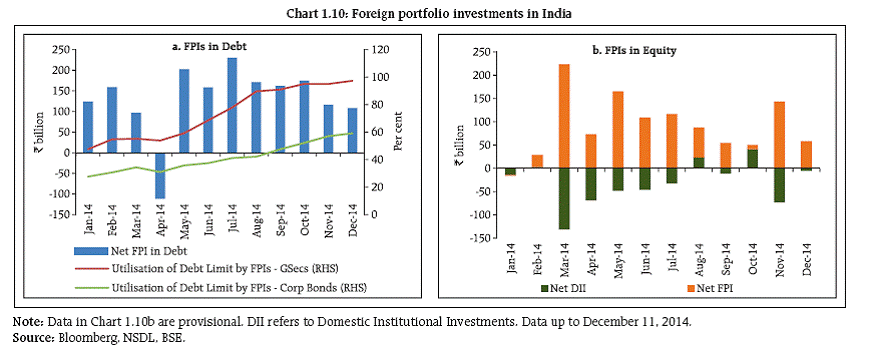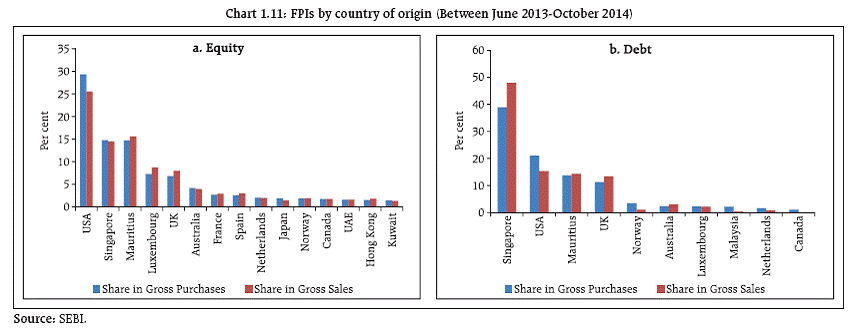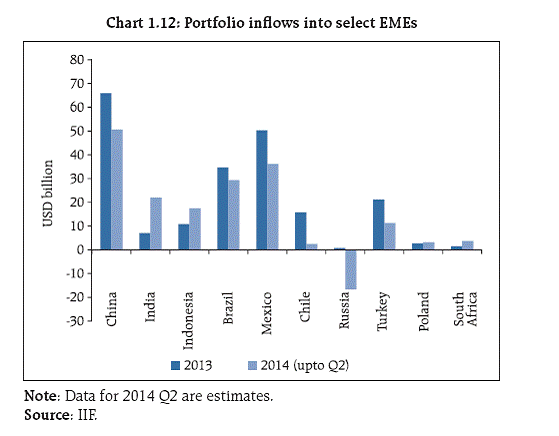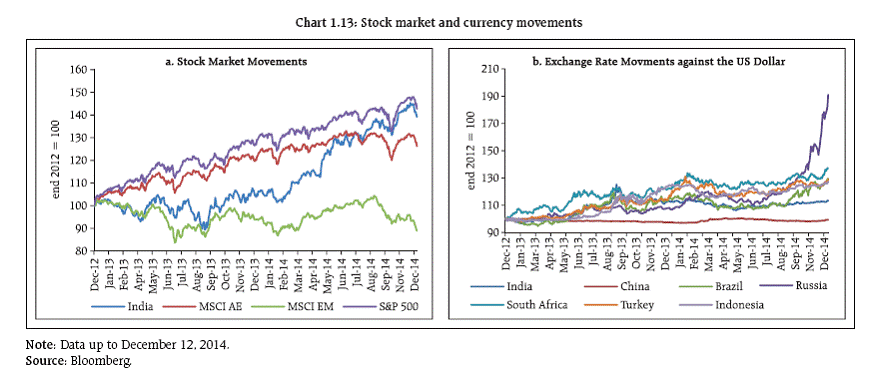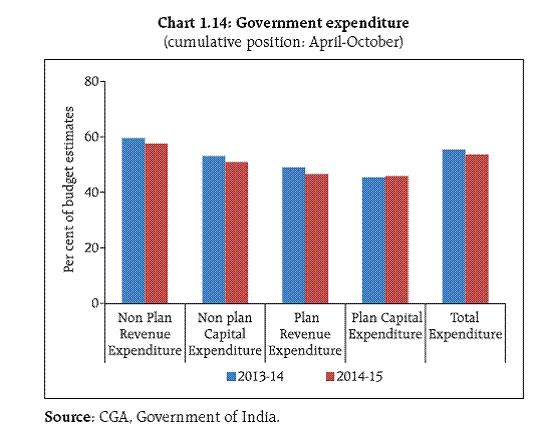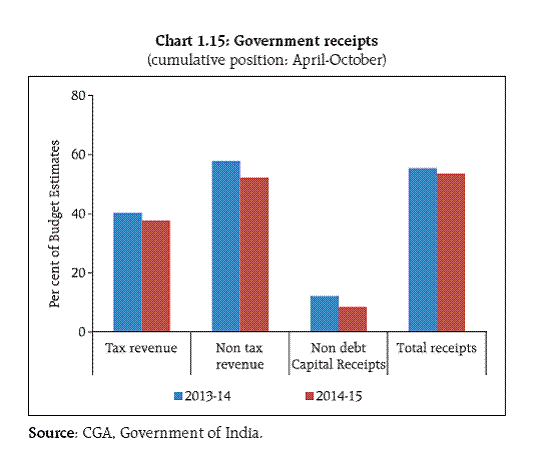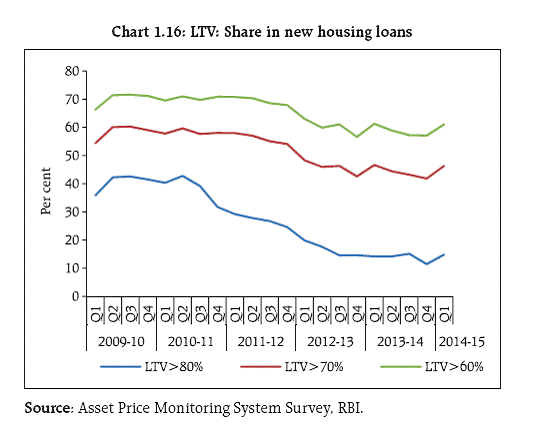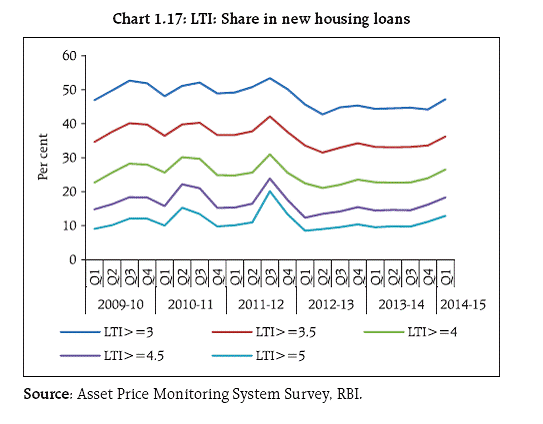 IST,
IST,
Chapter I : Macro-Financial Risks
The current weak global growth outlook may prolong easy monetary policy stance in most advanced economies (AEs). Consequently, low risk premia may lead to accumulation of vulnerabilities and sudden and sharp overshooting in markets cannot be ruled out. As of now, financial risk taking has not translated into commensurate economic risk taking. Against the backdrop of low interest rates in AEs, portfolio flows to emerging market and developing economies (EMDEs) have been robust, increasing the risk of reversals on possible adverse growth or financial market shocks, thus necessitating greater alertness. On the domestic front, macroeconomic vulnerabilities have abated significantly in recent months on the back of improvement in growth outlook, fall in inflation, recovery in the external sector and political stability. However, growth in the banking business and activity in primary capital markets remain subdued due to moderate investment intentions. Sustaining the turnaround in business sentiment remains contingent on outcomes on the ground. Global backdrop 1.1. Global recovery seems to have weakened. While economic growth is finding traction in the US, it appears to be slipping in the Euro area and seems to be reversing in Japan. Any hard landing in China is an additional risk to global growth. Further, geopolitical risks emanating from developments in the Middle East and Ukraine are also impacting the global economy. Without a change in the pattern of growth and stability that still leans heavily on easy money, vulnerabilities remain, especially with inflation ruling below policy targets in many jurisdictions and the threat of deflation continuing in others. 1.2. Against this backdrop, the prospects for global financial stability remain uncertain amidst an ambience wherein weak growth prospects are still considered benign for financial markets in the expectation that ultra-easy monetary policies will continue. Stock markets around the world, particularly in advanced economies (AEs) have been buoyant with lower volatility until recently, a situation earlier experienced in the period of financial excesses leading to the global financial crisis (Chart 1.1). Despite the end of quantitative easing (QE) in the US, carry trades are likely to continue with both the Bank of Japan (BOJ) and the European Central Bank (ECB) adding to global liquidity. Simultaneously, low yields are impacting pension and retirement funds prompting them to shift their investment strategies towards riskier options. Amidst this sense of relative serenity, the October 15 flash crash in US Treasury bond yields may be a harbinger of the risks that may unfold. Domestic macroeconomic conditions Growth 1.3. Domestic activity weakened in Q2 of 2014-15 with growth at 5.3 per cent. Activity is likely to be muted in Q3 also because of a moderate kharif harvest. Choppiness in the index of industrial production (IIP) growth during 2014-15, so far, has raised questions over consolidation of industrial growth. With capacity utilisation1 during Q1 2014-15 being the lowest in the last four years (Chart 1.2), significant new investments may take time to materialise. In addition, measures of new investment intentions currently show only a modest pickup in investments (Chart 1.3). The Reserve Bank’s current central estimate for GDP for 2014-15 is placed at 5.5 per cent with a gradual pickup in momentum through 2015-16. Inflation 1.4. High and persistent inflation often gets entrenched into inflation expectations and leads to uncertainty over prices. As a result, high inflation can adversely impact investment and consumption decisions. Against this backdrop, the substantial easing in CPI inflation to 4.4 per cent in November 2014 from 11.2 per cent a year earlier (Chart 1.4) marks a significant improvement in the Indian macroeconomic environment. The Reserve Bank’s latest projections suggest that CPI inflation over the next 12 months may hover around 6 per cent if the international crude prices remain around the current levels and the monsoon next year turns out to be normal. Credit 1.5. Growth in bank credit and deposits has been relatively low in the recent past (Chart 1.5). Slowdown in credit growth has been broad-based barring agriculture and allied activities (Chart 1.6). Low credit growth reflects a combination of factors such as reliance on alternative sources of funding, balance sheet repair and slack in demand as also an element of risk aversion. However, pickup in credit assumes importance in the present context given that credit cycles have been leading business cycles in the post-reform period2 (Chart 1.7). Banks, therefore, need to prepare themselves to meet credit demand as investment picks up. Household financial savings 1.6. The gross domestic saving rate declined to 30.1 per cent in 2012-13, the lowest in the past nine years. This reduction is explained to a large extent by a fall in households’ financial saving rate (Chart 1.8) amid their shifting preferences towards physical assets and valuables. However, preliminary estimates of the household financial saving rate for 2013-14 show a marginal increase, largely with respect to bank deposits and small savings. Revival in investment activity needs to be supported by an increase in financial savings. External developments 1.7. With the containment of the current account deficit (CAD), improvement in capital inflows, relative stability of the exchange rate and accretion to the foreign exchange reserves, external vulnerability has reduced (Chart 1.9). While fall in global crude oil and commodity prices will help containing CAD, continuous vigil is warranted as capital inflows tend to be volatile. 1.8. Foreign portfolio investments (FPIs) into India were robust during 2014 (Charts 1.10a and b).Their heightened interest in debt may create volatility in domestic debt markets despite some evidence that FPIs are taking a longer term view on the Indian debt paper. Given the primacy of US based FPIs in India (Charts 1.11a and b), unexpected changes in the US monetary policy could have adverse effects on FPI flows through direct and indirect channels. Financial markets 1.9. Portfolio inflows into emerging market economies (EMEs) during 2014 were robust (Chart 1.12). Indian stocks and the rupee outperformed their counterparts in other EMEs (Charts 1.13 a and b). Though Indian stocks rose sharply after May 2014, they seem to be only catching up with the likes of MSCI AE and S&P 500 which started their upward movement much earlier. Improvement in overall macroeconomic conditions, a relatively stable exchange rate, return of political stability and expectations of growth enhancing reforms seem to have created a relative advantage in favour of India and unleashed the pent up demand for Indian assets. The challenge ahead is to reinforce expectations through commensurate structural reforms. Government expenditure 1.10. The Union Budget 2014-15 aimed at achieving higher growth along with macroeconomic stability through lower inflation, reduction in fiscal deficit and a manageable current account deficit. Available information for the first seven months of the current financial year indicates that total expenditure as percentage of budget estimates (BE) was lower compared to the corresponding period in the previous year, primarily on account of lower plan and non-plan revenue expenditure (Chart 1.14). Expenditure on major subsidies was significantly lower at 70.8 per cent of BE during first seven months of the current financial year (78.4 per cent a year ago). Overall capital expenditure was lower by 1.1 percentage points due to lower non-plan capital expenditure. 1.11. However, tax revenue as a percentage of BE was lower during April-October 2014-15 as compared to the previous year reflecting lower collections under all major taxes. Non-tax revenue as per cent of BE was also lower (Chart 1.15). The lower revenue mobilisation which is partly emanating from still subdued economic activity is a major concern. Mortgage debt: House prices and loan to value/ income ratios 1.12. House prices witnessed correction in many cities during Q1 2014-15.3 Further, the proportion of loans at high loan to value ratio (LTV) has been falling (Chart 1.16) and lending for housing at high loan to income ratio (LTI) is also relatively low4 (Chart 1.17). However, a reversal in directional movement in LTV and LTI has been observed in Q1 2014-15. 1.13. Development of housing and mortgage markets has an important role in growth and employment. Given that the government is committed to a policy of housing for all by 2022, the housing sector has immense potential to grow; so do the mortgage markets. In this context, the Securities and Exchange Board of India (SEBI) recently notified the SEBI (Real Estate Investment Trusts) Regulations, 2014 (Box 1.1). These regulations are expected to aid the development of the real estate sector in India with benefits accruing to all stakeholders. Box 1.1: Real Estate Investment Trusts Globally, units of Real Estate Investment Trusts (REITs) sell like stocks on major exchanges and they invest in real estate directly, either in properties or mortgages. They enjoy special tax considerations and typically offer investors high yields as well as a framework for wider investor participation in real estate. Most of the REIT earnings are distributed to shareholders regularly as dividends. According to the European Public Real Estate Association’s (EPRA) Global REIT Survey 2014, 37 countries worldwide have REITs or ‘REIT-like’ legislations in place. The structure of REITs varies across countries and it is constantly evolving.5 Since their introduction in Asia in the early 2000s, REITs have been adopted across the continent, growing into a market worth over USD 140 billion.6 REITs are mainly of three types: Equity REITs, Mortgage REITs and Hybrid REITs. Equity REITs invest in and own properties and their revenues come principally from rents. Mortgage REITs invest in real estate and mortgage backed securities and their revenues are generated primarily as interest income that they earn on the mortgage loans. Hybrid REITs combine the investment strategies of Equity REITs and Mortgage REITs by investing in both properties and mortgages. Like any other investment, investments in REITs have their own set of risks. Mortgage REITs (mREITs) are involved in lending money to owners of real estate and buying (mostly agency backed) mortgage backed securities (MBS) and their business model layers on other risks that could amplify market dislocations. Some of these are: a) Funding and liquidity risk, b) Refinancing and rollover risk, c) Maturity mismatch risk, d) Convexity risk, e) Concentration and correlation risk and f) Market risk. These risks, in turn, are interrelated and their presence can lead to a fire sale event. However, in India, the current REIT regulations do not provide for mREITs and are aimed at developing the real estate sector in a robust manner. 1 Based on data from the RBI’s Quarterly Order Books, Inventories and Capacity Utilisation Survey. |
पृष्ठ अंतिम बार अपडेट किया गया:






